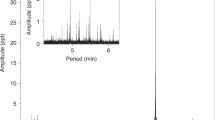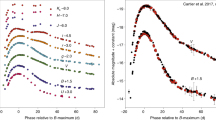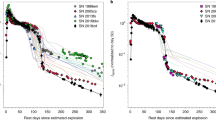Abstract
The accelerating expansion of the Universe, and the need for dark energy, were inferred from observations1,2 of type Ia supernovae. There is a consensus that type Ia supernovae are thermonuclear explosions that destroy carbon–oxygen white dwarf stars that have accreted matter from a companion star3, although the nature of this companion remains uncertain. These supernovae are thought to be reliable distance indicators because they have a standard amount of fuel and a uniform trigger: they are predicted to explode when the mass of the white dwarf nears the Chandrasekhar mass4 of 1.4 solar masses (M⊙). Here we show that the high-redshift supernova SNLS-03D3bb has an exceptionally high luminosity and low kinetic energy that both imply a super-Chandrasekhar-mass progenitor. Super-Chandrasekhar-mass supernovae should occur preferentially in a young stellar population, so this may provide an explanation for the observed trend that overluminous type Ia supernovae occur only in ‘young’ environments5,6. As this supernova does not obey the relations that allow type Ia supernovae to be calibrated as standard candles, and as no counterparts have been found at low redshift, future cosmology studies will have to consider possible contamination from such events.
This is a preview of subscription content, access via your institution
Access options
Subscribe to this journal
Receive 51 print issues and online access
$199.00 per year
only $3.90 per issue
Buy this article
- Purchase on Springer Link
- Instant access to full article PDF
Prices may be subject to local taxes which are calculated during checkout




Similar content being viewed by others
References
Perlmutter, S. et al. Measurements of Omega and Lambda from 42 high-redshift supernovae. Astrophys. J. 517, 565–586 (1999)
Riess, A. G. et al. Observational evidence from supernovae for an accelerating Universe and a cosmological constant. Astron. J. 116, 1009–1038 (1998)
Hoyle, F. & Fowler, W. A. Nucleosynthesis in supernovae. Astrophys. J. 132, 565–590 (1960)
Chandrasekhar, S. The maximum mass of ideal white dwarfs. Astrophys. J. 74, 81–82 (1931)
Sullivan, M. et al. Rates and properties of type Ia supernovae as a function of mass and star-formation in their host galaxies. Astrophys. J. (in the press); preprint at http://www.arXiv.org/astro-ph/0605455 (2006)
Hamuy, M. et al. The absolute luminosities of the Calan/Tololo type IA supernovae. Astron. J. 112, 2391–2397 (1996)
Astier, P. et al. The Supernova Legacy Survey: measurement of ΩM, ΩΛ and w from the first year data set. Astron. Astrophys. 447, 31–48 (2006)
Howell, D. A., Höflich, P., Wang, L. & Wheeler, J. C. Evidence for asphericity in a subluminous type Ia supernova: spectropolarimetry of SN 1999by. Astrophys. J. 556, 302–321 (2001)
Kasen, D., Nugent, P., Thomas, R. C. & Wang, L. Could there be a hole in type Ia supernovae? Astrophys. J. 610, 876–887 (2004)
Phillips, M. M. The absolute magnitudes of type IA supernovae. Astrophys. J. Lett. 413, L105–L108 (1993)
Colgate, S. A. & McKee, C. Early supernova luminosity. Astrophys. J. 157, 623–644 (1969)
Woosley, S. E. & Weaver, T. A. The physics of supernova explosions. Annu. Rev. Astron. Astrophys. 24, 205–253 (1986)
Branch, D. The Hubble constant from nickel radioactivity in type IA supernovae. Astrophys. J. 392, 35–40 (1992)
Nomoto, K., Thielemann, F.-K. & Yokoi, K. Accreting white dwarf models of Type I supernovae. III—Carbon deflagration supernovae. Astrophys. J. 286, 644–658 (1984)
Hoflich, P. Analysis of the type IA supernova SN 1994D. Astrophys. J. 443, 89–108 (1995)
Khokhlov, A., Mueller, E. & Hoeflich, P. Light curves of type IA supernova models with different explosion mechanisms. Astron. Astrophys. 270, 223–248 (1993)
Fisher, A., Branch, D., Hatano, K. & Baron, E. On the spectrum and nature of the peculiar type IA supernova 1991T. Mon. Not. R. Astron. Soc. 304, 67–74 (1999)
Yoon, S.-C. & Langer, N. On the evolution of rapidly rotating massive white dwarfs towards supernovae or collapses. Astron. Astrophys. 435, 967–985 (2005)
Tutukov, A. V. & Yungelson, L. R. Merging of binary white dwarfs neutron stars and black-holes under the influence of gravitational wave radiation. Mon. Not. R. Astron. Soc. 268, 871–879 (1994)
Howell, D. A. The progenitors of subluminous type Ia supernovae. Astrophys. J. Lett. 554, L193–L196 (2001)
Arnett, W. D. Type I supernovae. I—Analytic solutions for the early part of the light curve. Astrophys. J. 253, 785–797 (1982)
Arnett, W. D., Branch, D. & Wheeler, J. C. Hubble's constant and exploding carbon-oxygen white dwarf models for type I supernovae. Nature 314, 337–338 (1985)
Nugent, P. et al. Low Hubble constant from the physics of type Ia supernovae. Phys. Rev. Lett. 75, 394–397 (1995)
Nugent, P. E. Non-local thermodynamic equilibrium spectrum synthesis of type IA supernovae. PhD thesis, Univ. Oklahoma (1997)
Conley, A. et al. The rise time of type Ia supernovae from the Supernova Legacy Survey. Astron. J. (in the press); preprint at http://www.arXiv.org/astro-ph/0607363 (2006)
Benetti, S. et al. The diversity of type Ia supernovae: evidence for systematics? Astrophys. J. 623, 1011–1016 (2005)
Nugent, P., Kim, A. & Perlmutter, S. K-corrections and extinction corrections for type Ia supernovae. Publ. Astron. Soc. Pacif. 114, 803–819 (2002)
Bessell, M. S. UBVRI passbands. Publ. Astron. Soc. Pacif. 102, 1181–1199 (1990)
Fisher, A., Branch, D., Nugent, P. & Baron, E. Evidence for a high-velocity carbon-rich layer in the type IA SN 1990N. Astrophys. J. Lett. 481, L89–L92 (1997)
Marion, G. H. et al. Low carbon abundance in type Ia supernovae. Astrophys. J. 645, 1392–1401 (2006)
Acknowledgements
SNLS relies on observations with MegaCam, a joint project of CFHT and CEA/DAPNIA, at the Canada–France–Hawaii Telescope (CFHT). We used data products from the Canadian Astronomy Data Centre as part of the CFHT Legacy Survey. Some data were obtained at the W. M. Keck Observatory. We acknowledge support from NSERC, NERSC, CIAR, CNRS/IN2P3, CNRS/INSU, CEA and the DOE.
Author information
Authors and Affiliations
Corresponding author
Ethics declarations
Competing interests
Reprints and permissions information is available at www.nature.com/reprints. The authors declare no competing financial interests.
Supplementary information
Supplementary Notes
This file contains Supplementary Methods, Supplementary Figure, Supplementary Table and additional references. (PDF 141 kb)
Rights and permissions
About this article
Cite this article
Andrew Howell, D., Sullivan, M., Nugent, P. et al. The type Ia supernova SNLS-03D3bb from a super-Chandrasekhar-mass white dwarf star. Nature 443, 308–311 (2006). https://doi.org/10.1038/nature05103
Received:
Accepted:
Issue Date:
DOI: https://doi.org/10.1038/nature05103
This article is cited by
-
Relevance of Dynamical Nuclear Processes in Quantum Complex Systems of Massive White Dwarfs
Brazilian Journal of Physics (2021)
-
Prospect of Chandrasekhar’s limit against modified dispersion relation
General Relativity and Gravitation (2020)
-
Observational properties of thermonuclear supernovae
Nature Astronomy (2019)
-
General relativistic effects in the structure of massive white dwarfs
General Relativity and Gravitation (2018)
-
Type Ia Supernova Cosmology
Space Science Reviews (2018)
Comments
By submitting a comment you agree to abide by our Terms and Community Guidelines. If you find something abusive or that does not comply with our terms or guidelines please flag it as inappropriate.



